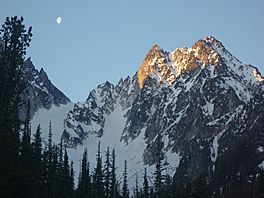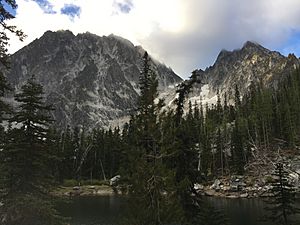Colchuck Glacier facts for kids
Quick facts for kids Colchuck Glacier |
|
|---|---|

Colchuck Glacier (at left) and Colchuck Peak from north in May, 2015
|
|
| Type | Alpine glacier |
| Location | Wenatchee National Forest, Chelan County, Washington, U.S. |
| Coordinates | 47°28′48″N 120°50′24″W / 47.48000°N 120.84000°W |
| Length | .30 mi (0.48 km) |
| Terminus | Barren rock |
| Status | Retreating |
Colchuck Glacier is a cool ice formation found in the Stuart Range of Washington, U.S. It sits just north of two tall mountains, Colchuck Peak and Dragontail Peak. This glacier is part of the beautiful Alpine Lakes Wilderness area, which is inside the Wenatchee National Forest.
The glacier is about .30 mi (0.48 km) long. At its widest, it stretches about .10 mi (0.16 km) across. It slopes down from high up in the mountains, starting at about 7,600 ft (2,300 m) and ending at 6,400 ft (2,000 m). At its lowest point, the ice rests on bare rock and loose stones.
Right below the glacier is Colchuck Lake. Both the mountain and the glacier get their name from this lake. In an old language called Chinook Jargon, "Colchuck" means "cold water."
Contents
Colchuck Glacier: A Mountain of Ice
Colchuck Glacier is a type of glacier known as an alpine glacier. These glaciers form in mountain valleys. They are like very slow-moving rivers made of ice. Over many years, snow falls and piles up. It gets squeezed and turns into dense ice. This ice then starts to flow downhill because of gravity.
Where is Colchuck Glacier?
Colchuck Glacier is located in the Cascade Range of Washington state. This area is known for its rugged mountains and beautiful scenery. The glacier is specifically in the Stuart Range, which is a sub-range of the Cascades. It's part of the Alpine Lakes Wilderness, a protected area. This means the land is kept wild and natural. The entire region is managed by the Wenatchee National Forest.
What is a Glacier?
A glacier is a huge body of ice that moves slowly over land. Glaciers form in places where more snow falls in winter than melts in summer. Over time, layers of snow build up. The weight of the new snow presses down on the old snow. This pressure turns the snow into solid ice.
How Glaciers Form
Imagine fresh, fluffy snow. As more snow falls on top, the bottom layers get squashed. The snowflakes change shape and become denser. Eventually, they turn into a granular ice called firn. With even more pressure, the firn compacts into glacial ice. This ice is so thick that it starts to flow like a very slow river. Glaciers can carve out valleys and shape mountains over thousands of years.
Why is Colchuck Glacier Shrinking?
The Colchuck Glacier is currently "retreating." This means it is getting smaller. A glacier retreats when it melts faster than new snow can build it up. It's like a bank account where you're spending more money than you're putting in.
Measuring Glacier Change
Scientists study glaciers like Colchuck Glacier to understand how our planet is changing. They use photos, maps, and special equipment to measure how much glaciers grow or shrink each year. When glaciers retreat, it often means that temperatures in the area are getting warmer. This can affect local water supplies and ecosystems.
The image on the left shows how much Colchuck Glacier has shrunk. You can see the bare rock where the glacier used to be. This shows the "current extent of glacial retreat."



